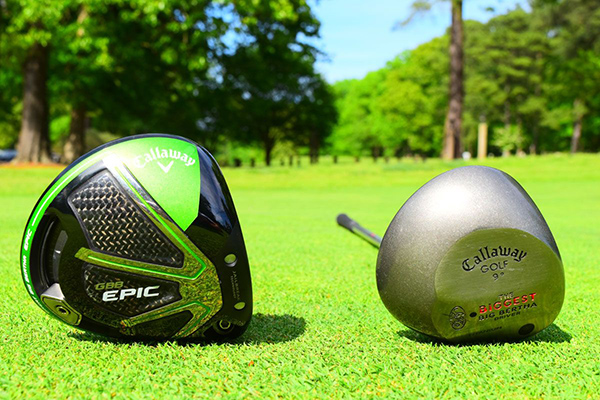
The Evolution of Golf Club Technology: From Hickory to High-Tech
From the humble beginnings of hickory clubs and feathery balls to the cutting-edge high-tech materials used today, the history of golf club technology is a fascinating journey of innovation and adaptation.
We will explore how golf clubs have evolved over time, from the introduction of steel shafts and rubber cores to the impact of modern technology on club design.
Delve into the past, present, and future of golf club technology to discover how it continues to shape the game of golf.
The History of Golf Club Technology
The history of golf club technology is a tale of constant evolution and innovation in materials, design, and performance. It traces back to the early days when golfers used rudimentary clubs made of hickory and had to adapt to the limitations of those primitive tools.
As time progressed, golf club technology saw significant advancements with the introduction of steel shafts, which offered more durability and consistency in performance. The development of perimeter-weighted clubheads in the mid-20th century revolutionized the game by enhancing forgiveness and accuracy in off-center hits. These breakthroughs, coupled with advancements in club fitting and customization, have played a crucial role in shaping the modern golf equipment industry.
Historical research and continuous development have paved the way for golfers to enjoy enhanced playability and performance on the course.
How Did Golf Clubs Evolve Over Time?
Golf clubs have undergone a remarkable evolution over time, transforming from simple hickory implements to high-tech marvels of modern engineering and design.
Historical research and development have played a crucial role in propelling the evolution of golf club technology through various key stages. As materials used in club production advanced, from hickory to steel and now lightweight graphite, the performance and durability of clubs improved. Innovations in design, such as cavity backs, perimeter weighting, and adjustable features, have led to increased forgiveness and customization for players. These advancements have not only enhanced the overall playing experience for golfers but also driven competitive evolution in the sport.
The Early Days: Hickory Clubs and Feathery Balls
The early days of golf saw players wielding clubs crafted from hickory, paired with feathery balls. This era marked the humble beginnings of golf club technology, with golfers experimenting with different materials for better performance.
Hickory, known for its strength and flexibility, was a popular choice for club shafts due to its ability to withstand the force of a swing.
The feathery balls, made of leather and stuffed with feathers, lacked durability and consistency, posing a challenge for golfers.
As the sport evolved, players sought ways to overcome these limitations, leading to the development of more durable materials like gutta-percha for golf balls and steel for club heads.
These advancements revolutionized the game, allowing for greater distance, accuracy, and control in golfing equipment.
What Were the First Golf Clubs Made Of?
The first golf clubs were predominantly crafted from hickory wood, known for its durability and flexibility characteristics. Golfers of the past relied on the natural properties of hickory to enhance their game.
Hickory wood, with its strength and resilience, provided golfers with clubs that could withstand the rigors of the game and offer consistent performance. The flexibility of hickory allowed craftsmen to shape the clubs with precision, ensuring a balance between power and control in each swing. As golf evolved over the years, the use of hickory in club construction became synonymous with tradition and excellence, paving the way for advancements in club technology. The historical significance of hickory in golf club manufacturing illustrates its enduring impact on the sport’s development.”
How Did Golfers Adapt to the Limitations of Early Clubs?
Golfers in the early days faced the challenge of adapting to the limitations of their hickory clubs, prompting them to explore innovative design solutions and performance enhancements.
These early golfers found themselves constantly tweaking their swing techniques and adjusting their playing styles to compensate for the shortcomings of the equipment.
Over time, they began experimenting with different materials and clubhead shapes, leading to the evolution of club designs.
Innovation played a crucial role in driving progress, as golfers tirelessly sought ways to improve their game.
This continuous development eventually paved the way for the introduction of new technologies that revolutionized golf club design and performance capabilities.
What Impact Did Steel Shafts Have on Golf Club Technology?
Steel shafts revolutionized golf club technology by offering increased durability, improved consistency, and enhanced performance characteristics for players seeking precision in their swings.
The introduction of steel shafts in golf clubs brought about numerous advantages that significantly enhanced the player experience on the course. These innovative materials not only provided a sturdier and more reliable option compared to traditional shafts but also allowed for more consistent ball striking and increased power transfer during swings. The advancements in steel shaft technology played a crucial role in influencing the design of modern clubs, leading to sleeker and more technologically advanced golf equipment that catered to varying skill levels and playing styles.
The Rise of High-Tech Materials
The golf industry witnessed a surge in high-tech materials being incorporated into golf club designs, ushering in a new era of performance and innovation on the course.
These innovative materials, such as titanium, carbon fiber, and composite alloys, have revolutionized the way golf clubs are constructed, offering improved strength, flexibility, and weight distribution. Materials science has played a crucial role in optimizing club performance by enhancing swing speed, accuracy, and distance control. The utilization of advanced materials has not only improved the overall playing experience for golfers of all skill levels but has also enabled manufacturers to push the boundaries of design, creating clubs that are both visually striking and functionally superior.
What Materials Have Been Used to Make Golf Clubs More High-Tech?
Modern golf clubs leverage cutting-edge materials such as carbon fiber, titanium, and composite alloys to achieve superior performance metrics and enhance player experience on the course.
These advanced materials have revolutionized the golf industry by offering a perfect blend of strength, durability, and lightness. Carbon fiber, known for its high strength-to-weight ratio, allows for a more precise and controlled swing, resulting in increased club head speed and greater distance. Titanium, on the other hand, provides excellent shock absorption, reducing vibration and enhancing the feel of impact with the ball. Composite alloys offer a customizable mix of properties, enabling club designers to create tailored solutions for golfers of varying skill levels.
How Have These Materials Improved Performance?
The integration of high-tech materials in golf club construction has significantly enhanced performance aspects such as distance, accuracy, and forgiveness, providing players with a competitive edge on the course.
These advanced materials, including carbon fiber, titanium, and high-strength steel, have revolutionized club design by allowing for optimized weight distribution, increased clubhead speed, and higher launch angles. Golfers can now achieve longer drives due to the enhanced energy transfer and reduced vibrations offered by these modern materials. The use of innovative composites and alloys has resulted in clubs with larger sweet spots, enabling golfers to hit more accurate shots and recover from mishits with greater ease.
The Impact of Technology on Golf Club Design
The infusion of technology into golf club design has revolutionized the way clubs are engineered, with a strong emphasis on optimizing clubhead speed, enhancing aerodynamics, and offering customization options for players.
This evolution in design has directly impacted the performance of golfers on the course. Advancements in clubhead speed have allowed players to achieve greater distances with their shots, while improved aerodynamics have enhanced precision and control. The integration of engineering innovations has led to clubs that are not only more efficient but also more forgiving, catering to a wide range of skill levels.
Customization trends have further personalized the golfing experience, with players able to tailor clubs to their unique preferences and playing styles. As the industry continues to evolve, technology remains at the forefront of shaping the future of golf club design.
How Has Technology Affected the Design of Golf Clubs?
Technological advancements have redefined golf club design by prioritizing innovation, performance optimization, and customization capabilities to meet the evolving demands of players and the golf industry.
Through the integration of advanced materials like carbon fiber and titanium, golf clubs now offer a perfect balance of strength and lightweight construction. These materials contribute to increased clubhead speed, enhanced control, and improved overall performance on the course.
The use of computer-aided design (CAD) and simulation software allows for precise shaping of club heads and crafting of intricate designs that cater to specific player preferences. This level of customization ensures that golfers can find clubs tailored to their individual swing characteristics and playing style.
What Are Some Examples of Innovative Golf Club Designs?
Innovative golf club designs encompass a wide range of features, from adjustable hosels and smart technology integration to advanced materials and performance-tested components, reflecting the dynamic landscape of golf equipment innovation.
These cutting-edge designs are revolutionizing the way golfers approach their game, offering customization options that were once unheard of. Manufacturers are pushing the boundaries of traditional club construction by integrating sensors and trackers to provide real-time feedback on swing metrics, allowing players to fine-tune their performance.
The use of premium materials like carbon fiber and titanium not only enhance durability but also optimize weight distribution for improved control and distance. Golfers can now tailor their clubs to their specific preferences, from loft and lie adjustments to personalized shaft options, leading to a more tailored and efficient playing experience.
The Future of Golf Club Technology
The future of golf club technology holds promises of further advancements in engineering, performance capabilities, sustainability practices, and meeting the evolving market demands of players and enthusiasts.
As technology continues to evolve and new materials are developed, golf clubs are expected to become even more precise, offering enhanced control, distance, and forgiveness. Engineers are exploring ways to optimize club design through advanced simulations and data analytics, leading to clubs that are tailored to individual swing profiles.
Sustainability is also a key focus, with the industry shifting towards eco-friendly materials and manufacturing processes. This alignment with sustainability initiatives not only benefits the environment but also resonates with the increasing demand for environmentally conscious products among consumers.
What Can We Expect to See in the Future of Golf Club Technology?
The future of golf club technology is poised to introduce revolutionary advancements in engineering precision, sustainable materials, and personalized customization options to cater to the diverse needs of players and the growing market demand.
These breakthroughs in engineering precision are anticipated to bring forth clubs that offer unparalleled accuracy and consistency in performance on the golf course. With sustainable material choices becoming increasingly important in the industry, golf club manufacturers are exploring innovative ways to incorporate eco-friendly materials without compromising on durability or performance. Enhanced customization features are set to empower players to tailor their clubs to their unique playing styles and preferences, providing a more personalized and enjoyable experience on the course.
How Will Technology Continue to Shape the Game of Golf?
Technology will play a pivotal role in shaping the future of golf, influencing everything from club design and performance metrics to player experiences and industry dynamics.
As advancements in golf club technology continue to evolve, players will have access to clubs that offer enhanced precision, distance, and forgiveness. These technological developments not only improve individual performance but also contribute to shifting industry trends towards customization and personalization. With the growing demand for innovative features, manufacturers are constantly refining their designs to meet consumer expectations, creating a competitive landscape where staying ahead in technology becomes a crucial aspect of maintaining a competitive edge on the course.


